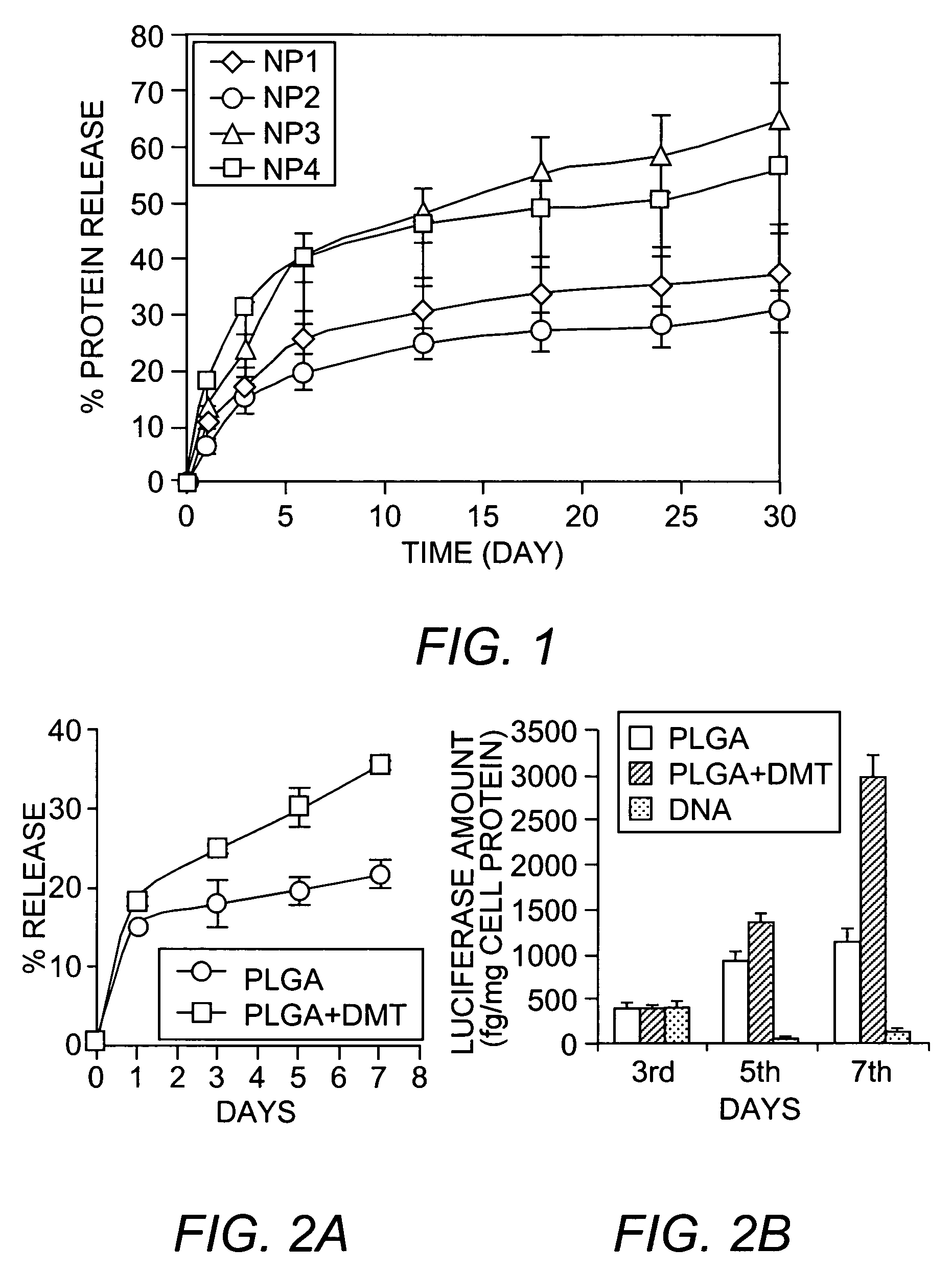Method and composition for inhibiting reperfusion injury in the brain
a brain and reperfusion injury technology, applied in the direction of drug compositions, peptide/protein ingredients, applications, etc., can solve the problems of inability to inhibit the release of antioxidants, significant correlation with infarct size, and inability to inhibit the release of oxygen radicals, so as to facilitate sustained release of antioxidants, inhibit the release of reperfusion injury, and inhibit the effect of reperfusion injury
- Summary
- Abstract
- Description
- Claims
- Application Information
AI Technical Summary
Benefits of technology
Problems solved by technology
Method used
Image
Examples
example 1
Formulation and Characterization of Nanoparticles
[0037]PLGA (90 mg; 50:50, inherent viscosity 1.31; Birmingham Polymers, Inc., Birmingham, Ala.) was dissolved in 3 mL of chloroform. Dimethyl tartrate (DMT or tartaric acid dimethyl ester; density 1.238 g / mL; Sigma, St. Louis, Mo.) was dissolved in the polymer solution. Protein (30 mg of BSA) was dissolved in 300 μL of water. The protein solution was emulsified into the PLGA solution by vortexing for 1 minute and then sonicating for 2 minutes at 55 Watts energy output using a probe sonicator (XL 2015 Sonicator® ultrasonic processor, Misonix, Inc., Farmingdale, N.Y.).
[0038]The resulting primary emulsion was further emulsified into 12 mL of 2% PVA solution (PVA average molecular weight 30,000-70,000) by vortexing followed by sonicating for 2 minutes at 55 Watts. PVA solution was filtered through a 0.22 micron syringe filter and saturated with chloroform prior to use. A few drops of chloroform were added at a time into the PVA solution, ...
example 2
SOD-Containing Nanoparticles
[0047]SOD-containing nanoparticles with DMT were formulated as described for BSA. In general, 10% DMT was used in the nanoparticle formulations. In addition to SOD, rat serum albumin (RSA) was included (in the place of BSA) and the SOD was dissolved into the RSA solution. Two formulations of SOD-containing nanoparticles were prepared: low dose SOD-containing nanoparticles (˜10,000 Units SOD dose), 6 mg SOD (1 mg SOD=4,750 Units) and 24 mg RSA; and high dose SOD-containing nanoparticles (˜20,000 Units SOD dose), 12 mg SOD and 18 mg RSA.
[0048]SOD loading in nanoparticles was determined by analyzing the amount of SOD that did not get encapsulated. For this purpose, the washings generated during the preparation of the nanoparticles, as disclosed herein, were collected and analyzed for SOD enzyme activity using a standard SOD enzyme assay kit (Dojindo Labs, Kumamoto, Japan). SOD loading into the nanoparticles was 4.5% (weight / weight; or 215 Units SOD per milli...
example 3
Targeting of Nanoparticles
[0052]Drug-loaded nanoparticles are surface modified with a protein transduction domain such as TAT peptide (SEQ ID NO:2) using an epoxy activation method. TAT peptide is a suitable targeting moiety as it has been effectively conjugated to proteins and liposomes (Torchilin, et al. (2001) Proc. Natl. Acad. Sci. USA 98:8786-91). To conjugate or link the TAT peptide to a nanoparticle, the nanoparticle surface is contacted with an epoxy compound (e.g., DENACOL®, Nagase America Co., CA) which reacts with the hydroxyl functional group of the PVA associated with the nanoparticle surface. In brief, 40 mg of drug-loaded nanoparticle dispersed in 4 mL borate buffer (pH 5.0) and 12 mg DENACOL® 524 (pentaepoxy) dissolved in equal volume of borate buffer is mixed and the reaction is allowed to take place for 30 minutes at 37° C. with gentle stirring in the presence of zinc tetrafluroborate acting as a catalyst. The unreacted DENACOL® is separated from the nanoparticles ...
PUM
| Property | Measurement | Unit |
|---|---|---|
| temperature | aaaaa | aaaaa |
| temperature | aaaaa | aaaaa |
| size | aaaaa | aaaaa |
Abstract
Description
Claims
Application Information
 Login to View More
Login to View More - R&D
- Intellectual Property
- Life Sciences
- Materials
- Tech Scout
- Unparalleled Data Quality
- Higher Quality Content
- 60% Fewer Hallucinations
Browse by: Latest US Patents, China's latest patents, Technical Efficacy Thesaurus, Application Domain, Technology Topic, Popular Technical Reports.
© 2025 PatSnap. All rights reserved.Legal|Privacy policy|Modern Slavery Act Transparency Statement|Sitemap|About US| Contact US: help@patsnap.com

